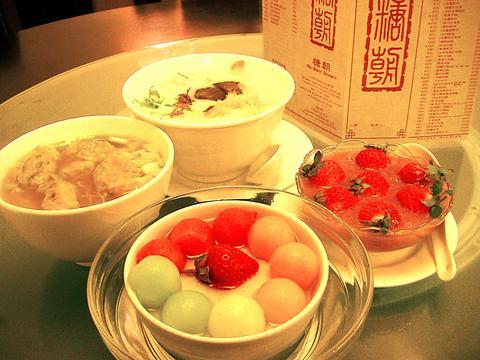If you have been to Sweet Dynasty on Canton Way in Kowloon, Hong Kong, and remember its food, then you will probably want to visit Sweet Dynasty in Taipei, which opened two months ago.
As popular as the original, customers wait on average for 30 minutes before getting a table and no reservations are accepted. Every day, 1,800 people come to the 70-table restaurant.
The secret of this restaurant's popularity is the refined taste of its food, which turns an ordinary dim-sum or night market item into a delicacy. There are more than 300 items on the menu, including noodles, rice, congee, stir-fried dishes and dim-sum and sweet soups, most of them familiar Hong Kong dishes.

PHOTO: YU SEN-LUN, TAIPEI TIMES
All-natural ingredients that emphasize a long cooking process and health-oriented sweets are three major features of food here. Fresh prawn congee (陳皮鮮蝦球粥) is a must-try for prawn lovers. The white rice congee contains eight to 10 fat prawns balls. From the chewy texture of the meat you can tell that they are fresh prawns just briefly sauteed. The Hong Kong style congee is famous for having stewed for so long and as a result the congee is so condensed that you don't see a grain of rice.
According to store manager Jamie Shu (殳建豐), the congee is added with dried soybean milk sheet when it's stewed, making it much smoother than any other congee you may find in Taipei. On top there are big slices of black mushrooms, shreds of dried citrus peels and dried scallops. The price of NT$280 for a bowl of rice congee may sound pricey but it is worth it.
Noodles with shrimp dumplings in soup (瑤柱鮮蝦水餃麵) is a choice for those wanting a stronger taste. Again, the shrimp dumplings are big and tasty, and they match well with the thin egg noodles in the soup.
The soup base is stewed with dried scallops and fresh fish so that it has a rich seafood flavor and is slightly salty if you're not used to Cantonese noodles.
At Sweet Dynasty, as the name might suggest, you cannot miss the sweets. Tofu pudding in a mini wooden pot (原木桶豆花) is a brand-name dessert, ideal for three to five people. According to Shu the soybeans for making the tofu pudding are imported from Canada and make the taste slightly different from tofu puddings in Taiwan, with a richer bean flavor.
For extra flavor you can try tofu pudding with almond soup, sesame soup, red bean soup, green bean soup or walnut soup. -- yu sen-lun

Many people noticed the flood of pro-China propaganda across a number of venues in recent weeks that looks like a coordinated assault on US Taiwan policy. It does look like an effort intended to influence the US before the meeting between US President Donald Trump and Chinese dictator Xi Jinping (習近平) over the weekend. Jennifer Kavanagh’s piece in the New York Times in September appears to be the opening strike of the current campaign. She followed up last week in the Lowy Interpreter, blaming the US for causing the PRC to escalate in the Philippines and Taiwan, saying that as

Taiwan can often feel woefully behind on global trends, from fashion to food, and influences can sometimes feel like the last on the metaphorical bandwagon. In the West, suddenly every burger is being smashed and honey has become “hot” and we’re all drinking orange wine. But it took a good while for a smash burger in Taipei to come across my radar. For the uninitiated, a smash burger is, well, a normal burger patty but smashed flat. Originally, I didn’t understand. Surely the best part of a burger is the thick patty with all the juiciness of the beef, the

This year’s Miss Universe in Thailand has been marred by ugly drama, with allegations of an insult to a beauty queen’s intellect, a walkout by pageant contestants and a tearful tantrum by the host. More than 120 women from across the world have gathered in Thailand, vying to be crowned Miss Universe in a contest considered one of the “big four” of global beauty pageants. But the runup has been dominated by the off-stage antics of the coiffed contestants and their Thai hosts, escalating into a feminist firestorm drawing the attention of Mexico’s president. On Tuesday, Mexican delegate Fatima Bosch staged a

Would you eat lab-grown chocolate? I requested a sample from California Cultured, a Sacramento-based company. Its chocolate, not yet commercially available, is made with techniques that have previously been used to synthesize other bioactive products like certain plant-derived pharmaceuticals for commercial sale. A few days later, it arrives. The morsel, barely bigger than a coffee bean, is supposed to be the flavor equivalent of a 70 percent to 80 percent dark chocolate. I tear open its sealed packet and a chocolatey aroma escapes — so far, so good. I pop it in my mouth. Slightly waxy and distinctly bitter, it boasts those bright,